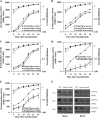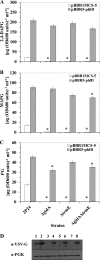Posttranscriptional regulation of 2,4-diacetylphloroglucinol production by GidA and TrmE in Pseudomonas fluorescens 2P24
- PMID: 24747907
- PMCID: PMC4054201
- DOI: 10.1128/AEM.00455-14
Posttranscriptional regulation of 2,4-diacetylphloroglucinol production by GidA and TrmE in Pseudomonas fluorescens 2P24
Abstract
Pseudomonas fluorescens 2P24 is a soilborne bacterium that synthesizes and excretes multiple antimicrobial metabolites. The polyketide compound 2,4-diacetylphloroglucinol (2,4-DAPG), synthesized by the phlACBD locus, is its major biocontrol determinant. This study investigated two mutants defective in antagonistic activity against Rhizoctonia solani. Deletion of the gidA (PM701) or trmE (PM702) gene from strain 2P24 completely inhibited the production of 2,4-DAPG and its precursors, monoacetylphloroglucinol (MAPG) and phloroglucinol (PG). The transcription of the phlA gene was not affected, but the translation of the phlA and phlD genes was reduced significantly. Two components of the Gac/Rsm pathway, RsmA and RsmE, were found to be regulated by gidA and trmE, whereas the other components, RsmX, RsmY, and RsmZ, were not. The regulation of 2,4-DAPG production by gidA and trmE, however, was independent of the Gac/Rsm pathway. Both the gidA and trmE mutants were unable to produce PG but could convert PG to MAPG and MAPG to 2,4-DAPG. Overexpression of PhlD in the gidA and trmE mutants could restore the production of PG and 2,4-DAPG. Taken together, these findings suggest that GidA and TrmE are positive regulatory elements that influence the biosynthesis of 2,4-DAPG posttranscriptionally.
Copyright © 2014, American Society for Microbiology. All Rights Reserved.
Figures





Similar articles
-
Transcriptional Regulator PhlH Modulates 2,4-Diacetylphloroglucinol Biosynthesis in Response to the Biosynthetic Intermediate and End Product.Appl Environ Microbiol. 2017 Oct 17;83(21):e01419-17. doi: 10.1128/AEM.01419-17. Print 2017 Nov 1. Appl Environ Microbiol. 2017. PMID: 28821548 Free PMC article.
-
Characterization the role of GacA-dependent small RNAs and RsmA family proteins on 2,4-diacetylphloroglucinol production in Pseudomonas fluorescens 2P24.Microbiol Res. 2020 Mar;233:126391. doi: 10.1016/j.micres.2019.126391. Epub 2019 Dec 9. Microbiol Res. 2020. PMID: 31865097
-
The outer membrane protein OprF and the sigma factor SigX regulate antibiotic production in Pseudomonas fluorescens 2P24.Microbiol Res. 2018 Jan;206:159-167. doi: 10.1016/j.micres.2017.10.006. Epub 2017 Oct 16. Microbiol Res. 2018. PMID: 29146252
-
Pleiotropic effects of RsmA and RsmE proteins in Pseudomonas fluorescens 2P24.BMC Microbiol. 2020 Jul 2;20(1):191. doi: 10.1186/s12866-020-01880-x. BMC Microbiol. 2020. PMID: 32615927 Free PMC article.
-
Role of 2,4-diacetylphloroglucinol-producing fluorescent Pseudomonas spp. in the defense of plant roots.Plant Biol (Stuttg). 2007 Jan;9(1):4-20. doi: 10.1055/s-2006-924473. Epub 2006 Oct 23. Plant Biol (Stuttg). 2007. PMID: 17058178 Review.
Cited by
-
GidA, a tRNA Modification Enzyme, Contributes to the Growth, and Virulence of Streptococcus suis Serotype 2.Front Cell Infect Microbiol. 2016 Apr 19;6:44. doi: 10.3389/fcimb.2016.00044. eCollection 2016. Front Cell Infect Microbiol. 2016. PMID: 27148493 Free PMC article.
-
Transcriptional Regulator PhlH Modulates 2,4-Diacetylphloroglucinol Biosynthesis in Response to the Biosynthetic Intermediate and End Product.Appl Environ Microbiol. 2017 Oct 17;83(21):e01419-17. doi: 10.1128/AEM.01419-17. Print 2017 Nov 1. Appl Environ Microbiol. 2017. PMID: 28821548 Free PMC article.
-
Identification and Characterization of Bacteria-Derived Antibiotics for the Biological Control of Pea Aphanomyces Root Rot.Microorganisms. 2022 Aug 8;10(8):1596. doi: 10.3390/microorganisms10081596. Microorganisms. 2022. PMID: 36014014 Free PMC article.
-
Bioprospecting of multi-stress tolerant Pseudomonas sp. antagonistic to Rhizoctonia solani for enhanced wheat growth promotion.Int Microbiol. 2025 Jan;28(1):17-35. doi: 10.1007/s10123-024-00517-7. Epub 2024 Apr 6. Int Microbiol. 2025. PMID: 38581482
-
Pseudomonas bijieensis Strain XL17 within the P. corrugata Subgroup Producing 2,4-Diacetylphloroglucinol and Lipopeptides Controls Bacterial Canker and Gray Mold Pathogens of Kiwifruit.Microorganisms. 2022 Feb 12;10(2):425. doi: 10.3390/microorganisms10020425. Microorganisms. 2022. PMID: 35208879 Free PMC article.
References
-
- Dwivedi D, Johri BN. 2003. Antifungals from fluorescent pseudomonads: biosynthesis and regulation. Curr. Sci. 85:1693–1703 http://www.iisc.ernet.in/~currsci/dec252003/1693.pdf
-
- Reddy TK, Khudiakov I, Borovkov PAV. 1968. Pseudomonas fluorescens strain 26-o—producer of phytotoxic substances. Mikrobiologiia 38:909–913 - PubMed
Publication types
MeSH terms
Substances
Associated data
- Actions
LinkOut - more resources
Full Text Sources
Other Literature Sources

